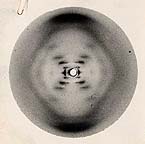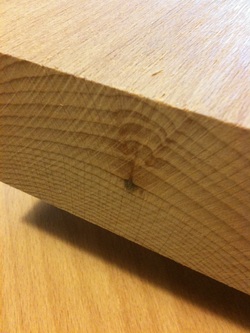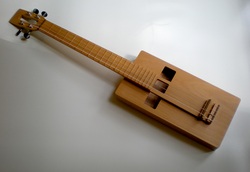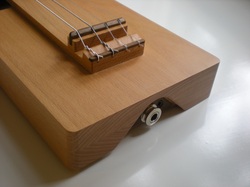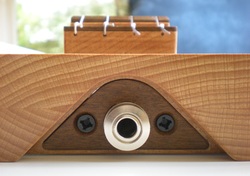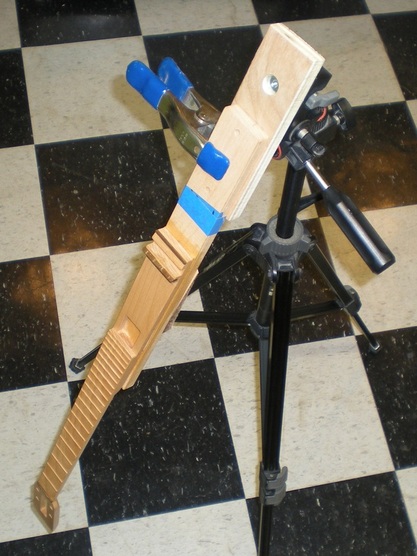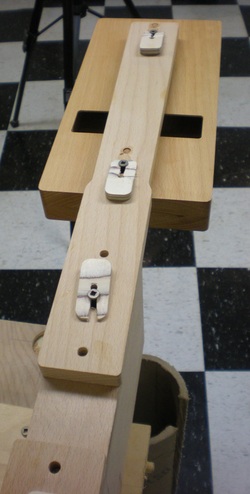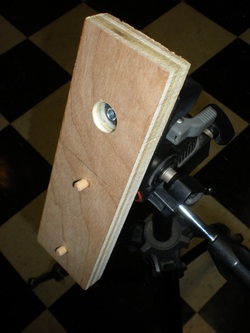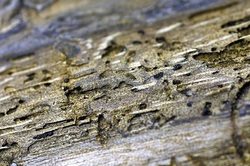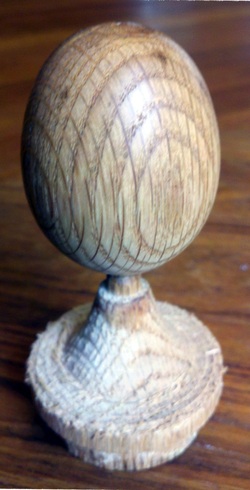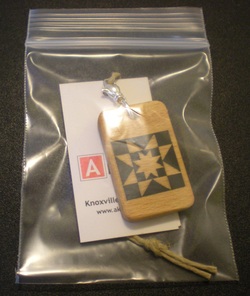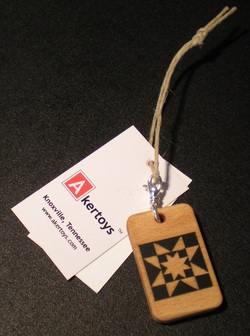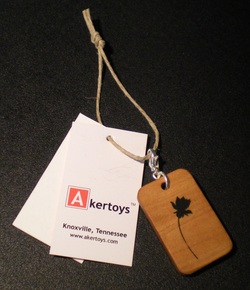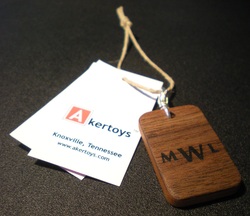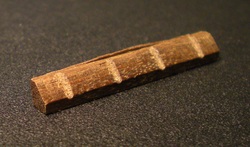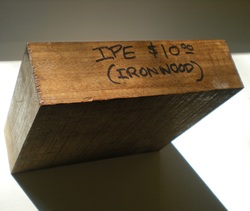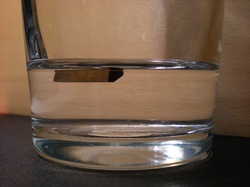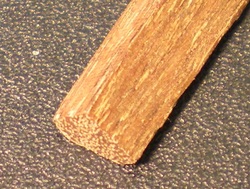If you saw the following image, would you say to yourself, "I believe this X-ray crystallograph is showing me a double helix structure?"
Apparently there are people who stare at such images enough that they can indeed make such conclusions. Crick and Watson, for instance, did just that when Rosalind Franklin showed them the image.
Or so the story goes. But this post is not intended to be mired in the question of who deserved the Nobel prize for discovering the structure of the DNA molecule. I'm sure they all worked very hard.
No, this post is intended to be mired in the question of how we learn to discern the nature of higher-order realities when we have never experienced those realities. Looking at the chopped end of the piece of beech in the image above, I was immediately reminded me of the DNA crystallography question: of what 3D structure is this interesting grain pattern a 2D section? Can only one 3D structure possibly result in such a section, or is it possible that seeing this particular section only narrows down the options... that we really still don't know for sure what sort of structure has distorted the rings?
When we experience a moment in time, our senses tell us all about the 3D nature of that moment. To gather the "full" 4D reality we have to remember what's come before and predict what will come next, somehow stringing the little paper dolls of each moment together into the fragile ribbon we call history. Everyone assembles the dolls differently, even if they're the same dolls.
A good friend of mine is (possibly even as I write this!) elaborating on a fascinating re-description of human experience. It may even become a Theory of Everything. It begins with a very logical, absolutely undeniable, statement, and steps outward until you must call into question everything you know.... and then go back out and live life as if you haven't called all these things into question. He's struggling, because it's really hard: in the end he has to assemble this theory just like those paper dolls I so poetically described. He sees the end of the board, and he's seen other ends of other boards, and he thinks it all looks a bit twisty.
Hello there! I'd like to show you a picture:
Yes, you are correct, you have seen one of these before. Hmm. Almost correct: this one is slightly different:
What on earth?? Is that... a strap-pin jack?? Yes, yes it is. That's a 1/4" hole that accepts a standard 1/4" audio plug, such as might be used to connect to an amplifier. Inside there it's attached to a piezoelectric pickup, adhered to the soundboard. You can't see that in the following image either:
We've had this all planned out for a long time, but it's taken a while to get all the pieces to come together. I cannot express how awesome it is to play around on one of our little ukes, enjoying myself as usual, and then plug it into my amp and enjoy myself louder... and with reverb... and other awesome effects! Super fun, unbelievable fun.
It's tricky to hold stuff. This is one of those things you don't really think about when you're a kid, and then at a certain point you realize that a huge percentage of all engineering effort has been applied toward trying to... hold stuff. We at Akertoys find it tricky to hold stuff while finishing it. Ukuleles in particular pose that challenge. Here's the latest solution:
We had set up a "finishing station" that held either four necks or four bodies at a time, using a little wedge-thingy to quickly disconnect the temporary finishing arm from the station when you needed to flip or remove the part.
A friend who was helping with the finishing pointed out that there's not a lot of point in having four of them set up that way at once: since we don't have spray finishing equipment, you can only really focus on one item at a time... so what might be most useful would be a single good workstation, and then a lot of places to hang the inactive parts for drying. So I imagined a little plate that could interface between the 1/4-20 male thread of a tripod and the two dowel holes of our finishing holding bars.
I realize we won't be winning any beauty contests with this thing... but that's cool. I think it's beautiful, considering the small amount of time invested in its creation. It does the job nicely, lets you hold a neck or body at any location in space while you work on it. Excellent.
Oh, and if you're wondering about the crummy, flash-polluted photography: My tripod was sort of indisposed at the time!
It's a lot of fun to make things out of wood, and there are so many different types of wood that it never gets boring. Still, it's fun to go cross-media sometimes:
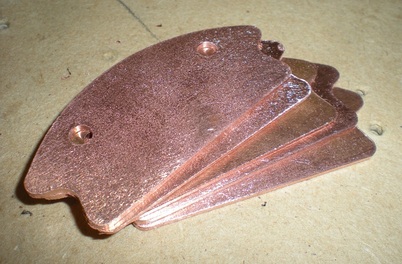
copper plates
I'm having trouble toggling the option that lets you enlarge the image by clicking on it.... hope you can see them okay. The general idea is that we had a chance to make some odd-shaped plates out of copper as part of a fabrication services job we did some time ago. I stumbled upon the pictures recently and remembered how much fun that was. When you work with wood all the time, your brain starts to develop an expectation of how heavy a little piece of material should be. Then you pick one of these off the table... and it's a lot heavier than it's supposed to be! Simple pleasures.
[Adan] The topic for this post was suggested to me last Friday, but I deemed it too depressing for an otherwise happy Friday. But now, apparently, I'm thinking it's okay to depress everyone? Sorry about that!
Jennifer brought this to my attention via a link to
this article in the Knoxville News Sentinel. If you'd like to know more about this truly awful threat to black walnut trees, definitely read the article. The KNS is not always a shining beacon of well-edited journalism, but this article gets the job done. I'm informed and scared now. The article mentions a couple of other such tree plagues that have done enormous damage recently. It's frightening. Pretty much any wood whose name you recognize is facing some threat of some sort.
My knee-jerk, head-in-sand reaction is always to think, "We mustn't use any wood that is in any way threatened!" But I have to remind myself that every time I buy a board of walnut, I cast a vote in favor of fighting this pest. It seems heartless, but when all the dust (saw and otherwise) settles we will only see significant research being done to protect trees that have commercial value. This may be through use in wood products, as we do, or as part of a tourist destination, as the hemlocks are in the Smokies, or in some other way. As long as my purchase doesn't cause someone to cut down the very last canker-resistant tree in existence, then it does more good than harm.
Aside from buying (responsibly harvested) wood, you can help in the manner suggested by this URL:
http://www.dontmovefirewood.org/ Although there are lots of ways humans help these pests to move around, moving firewood from an infected region to an uninfected one is a biggie. So... don't!
Ian asks, and answers: "What do you make when you got a lathe for Christmas and an Easy Rougher for your birthday? An Egg, of course!!"
That's pretty much exactly egg-sized... which is hilarious because Ian began this turning exercise with a chunk of oak sized for the fireplace! He wanted to pick a challenging wood for the Easy Rougher, and what better than white oak from the fire pile? Then he started turning, and turning... and the chips were flying... and once you get the chips started flying you never wanna stop... and now all that's left is this lovely egg, all smooth and buttered up with some beeswax.
Very nice.
[Adan] Just finished a couple of new magnetic pendants today, and I wanted to show some pictures. They're looking good. Check out the packaging and the new swivel hardware!
[Adan] Okay, here's the answer: that's a little piece of ipe, the wood also known as ironwood. It's the nut from one of our beta model baritone ukuleles, or will be after it sees a little more work.
In this paragraph I intended to write some interesting factoids about ipe, a.k.a. ironwood. The only trouble is that
Wikipedia has just informed me that "ironwood" is an overused name that may or may not describe about twenty different woods: "
Ironwood is a common name for a large number of woods that have a reputation for hardness. Usage of the name may (or may not) include the tree that yields this wood."The image above shows the block from which we made this nut, and the labeling that caused us to believe that "ipe" is "Ironwood." One of the things I was told upon buying this (quite heavy) block was that "ironwood will sink in water, you know." So I was eager to mention that in this article... but now I'm filled with doubt. Science to the rescue:
Well! Okay then... Let's make some measurements. Block dimensions are 17x16x4.7cm = 1278cm^3. Block mass is 1225g. Aha! Density is 0.96g/cm^3, which is why that nut was not interested in being a sinker demonstrator. It wasn't floating very high... but it sure wasn't sinking.
Time to abandon Wikipedia and seek a more obscure but perhaps more focussed reference: How about the
ipe page on the WoodsTheBest site? Looks good to me. Here they confirm: density should be in the range of 0.85-0.97, so our block is actually on the high end.
We chose this wood for two reasons: importantly, of course, its contrasting color, dark to beech's medium-light. Even more importantly, though, is the tonal effect. We hoped the higher density would correspond with a more efficient energy transfer, and in fact this seems to be the case. These little pieces, the nuts and saddles and tailbars, make a ceramic-like clinking noise when you bounce a few around in your hand. And the proof's in the pudding: the instrument does sound very nice!
This block that we have should, if used efficiently, be able to make a large supply of such attractive and functional instrument components.
[Adan] It seems that Wednesday posts somehow seem to end up on Saturday unless I do them on Tuesday... so here's your Wednesday Whatzit, with a little time to spare:
Clues... hmmmm. Okay, scale: that's a tiny scrap of wood. The end section is only ~3/16" x ~5/32"... Oh, who am I kidding, I live in a decimal world: it's 0.185" x 0.145" (...with a hypotenuse thrown in there for good measure. Feel free to calculate that and submit it with your guess.) Another clue: it's part of either a product or product prototype that has been discussed here.
Please submit guesses, including object and type of wood, and get in the running for the PRIZE! Um. Sorry, still no prize, but anyway, have fun!

